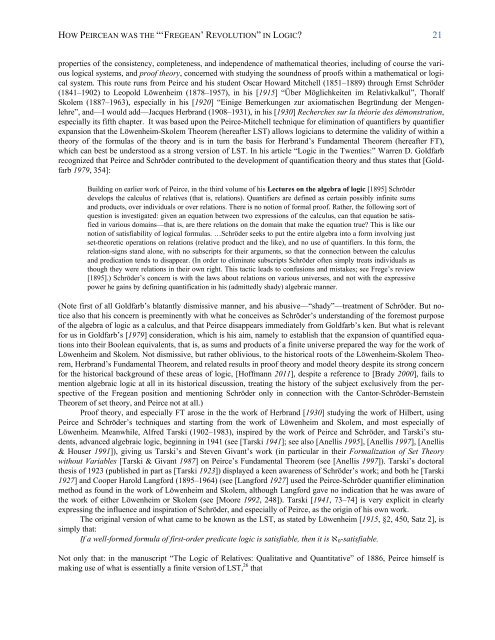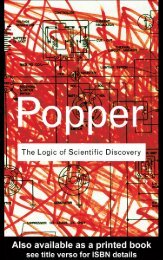You also want an ePaper? Increase the reach of your titles
YUMPU automatically turns print PDFs into web optimized ePapers that Google loves.
HOW PEIRCEAN WAS THE “‘FREGEAN’ REVOLUTION” IN LOGIC? 21<br />
properties of the consistency, completeness, and independence of mathematical theories, including of course the various<br />
logical systems, and proof theory, concerned with studying the soundness of proofs within a mathematical or logical<br />
system. This route runs from Peirce and his student Oscar Howard Mitchell (1851–1889) through Ernst Schröder<br />
(1841–1902) to Leopold Löwenheim (1878–1957), in his [1915] “Über Möglichkeiten im Relativkalkul”, Thoralf<br />
Skolem (1887–1963), especially in his [1920] “Einige Bemerkungen zur axiomatischen Begründung der Mengenlehre”,<br />
and—I would add—Jacques Herbrand (1908–1931), in his [1930] Recherches sur la théorie des démonstration,<br />
especially its fifth chapter. It was based upon the Peirce-Mitchell technique for elimination of quantifiers by quantifier<br />
expansion that the Löwenheim-Skolem Theorem (hereafter LST) allows logicians to determine the validity of within a<br />
theory of the formulas of the theory and is in turn the basis for Herbrand’s Fundamental Theorem (hereafter FT),<br />
which can best be understood as a strong version of LST. In his article “Logic in the Twenties:” Warren D. Goldfarb<br />
recognized that Peirce and Schröder contributed to the development of quantification theory and thus states that [Goldfarb<br />
1979, 354]:<br />
Building on earlier work of Peirce, in the third volume of his Lectures on the algebra of logic [1895] Schröder<br />
develops the calculus of relatives (that is, relations). Quantifiers are defined as certain possibly infinite sums<br />
and products, over individuals or over relations. There is no notion of formal proof. Rather, the following sort of<br />
question is investigated: given an equation between two expressions of the calculus, can that equation be satisfied<br />
in various domains—that is, are there relations on the domain that make the equation true? This is like our<br />
notion of satisfiability of logical formulas. …Schröder seeks to put the entire algebra into a form involving just<br />
set-theoretic operations on relations (relative product and the like), and no use of quantifiers. In this form, the<br />
relation-signs stand alone, with no subscripts for their arguments, so that the connection between the calculus<br />
and predication tends to disappear. (In order to eliminate subscripts Schröder often simply treats individuals as<br />
though they were relations in their own right. This tactic leads to confusions and mistakes; see Frege’s review<br />
[1895].) Schröder’s concern is with the laws about relations on various universes, and not with the expressive<br />
power he gains by defining quantification in his (admittedly shady) algebraic manner.<br />
(Note first of all Goldfarb’s blatantly dismissive manner, and his abusive—“shady”—treatment of Schröder. But notice<br />
also that his concern is preeminently with what he conceives as Schröder’s understanding of the foremost purpose<br />
of the algebra of logic as a calculus, and that Peirce disappears immediately from Goldfarb’s ken. But what is relevant<br />
for us in Goldfarb’s [1979] consideration, which is his aim, namely to establish that the expansion of quantified equations<br />
into their Boolean equivalents, that is, as sums and products of a finite universe prepared the way for the work of<br />
Löwenheim and Skolem. Not dismissive, but rather oblivious, to the historical roots of the Löwenheim-Skolem Theorem,<br />
Herbrand’s Fundamental Theorem, and related results in proof theory and model theory despite its strong concern<br />
for the historical background of these areas of logic, [Hoffmann 2011], despite a reference to [Brady 2000], fails to<br />
mention algebraic logic at all in its historical discussion, treating the history of the subject exclusively from the perspective<br />
of the Fregean position and mentioning Schröder only in connection with the Cantor-Schröder-Bernstein<br />
Theorem of set theory, and Peirce not at all.)<br />
Proof theory, and especially FT arose in the the work of Herbrand [1930] studying the work of Hilbert, using<br />
Peirce and Schröder’s techniques and starting from the work of Löwenheim and Skolem, and most especially of<br />
Löwenheim. Meanwhile, Alfred Tarski (1902–1983), inspired by the work of Peirce and Schröder, and Tarski’s students,<br />
advanced algebraic logic, beginning in 1941 (see [Tarski 1941]; see also [Anellis 1995], [Anellis 1997], [Anellis<br />
& Houser 1991]), giving us Tarski’s and Steven Givant’s work (in particular in their Formalization of Set Theory<br />
without Variables [Tarski & Givant 1987] on Peirce’s Fundamental Theorem (see [Anellis 1997]). Tarski’s doctoral<br />
thesis of 1923 (published in part as [Tarski 1923]) displayed a keen awareness of Schröder’s work; and both he [Tarski<br />
1927] and Cooper Harold Langford (1895–1964) (see [Langford 1927] used the Peirce-Schröder quantifier elimination<br />
method as found in the work of Löwenheim and Skolem, although Langford gave no indication that he was aware of<br />
the work of either Löwenheim or Skolem (see [Moore 1992, 248]). Tarski [1941, 73–74] is very explicit in clearly<br />
expressing the influence and inspiration of Schröder, and especially of Peirce, as the origin of his own work.<br />
The original version of what came to be known as the LST, as stated by Löwenheim [1915, §2, 450, Satz 2], is<br />
simply that:<br />
If a well-formed formula of first-order predicate logic is satisfiable, then it is �0-satisfiable.<br />
Not only that: in the manuscript “The Logic of Relatives: Qualitative and Quantitative” of 1886, Peirce himself is<br />
making use of what is essentially a finite version of LST, 26 that





